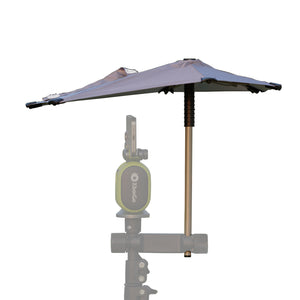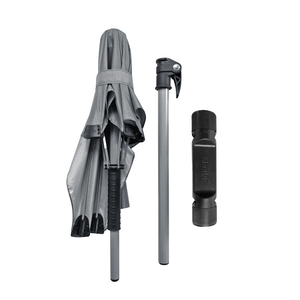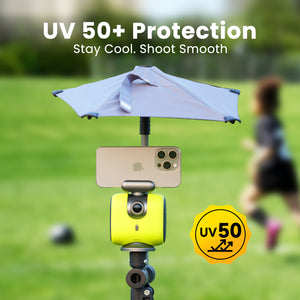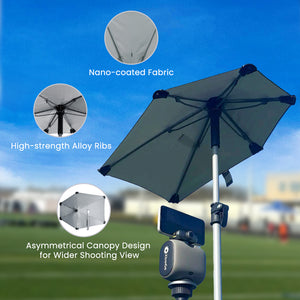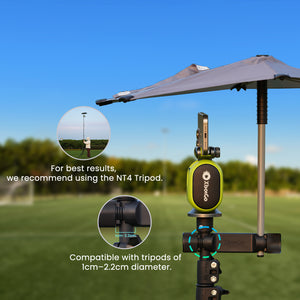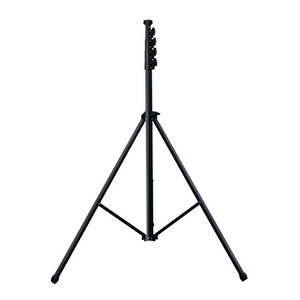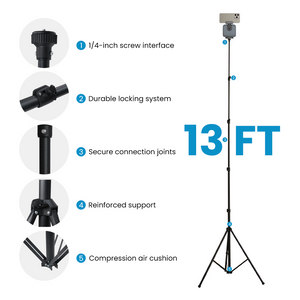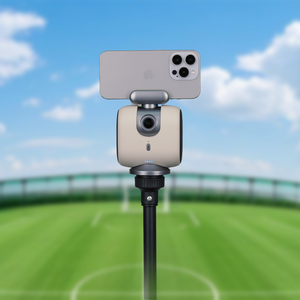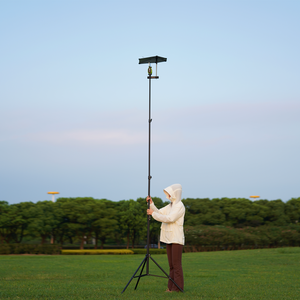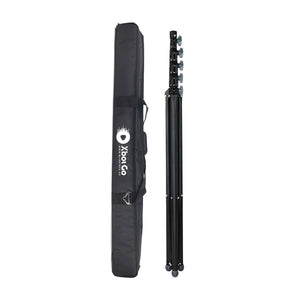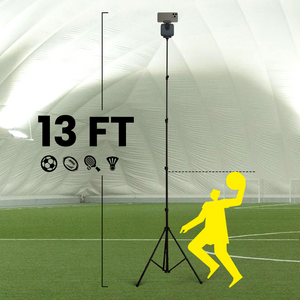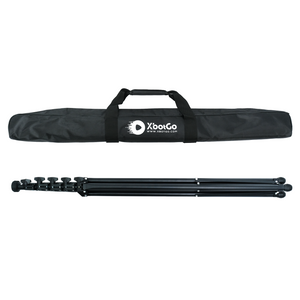XbotGo Chameleon AI Sports Camera
Cómo lavar el equipo de hockey: Elimina el mal olor de la pista para siempre
Todo jugador de hockey conoce ese olor inconfundible: el infame "hedor a pista" que te golpea en cuanto abres la bolsa de tu equipo. Pero ese olor es más que una simple vergüenza. Es señal de bacterias dañinas que pueden causar infecciones en la piel y que, además, están deteriorando lentamente el equipo que te ha costado miles de dólares.
¿La buena noticia? Con los métodos de limpieza adecuados, puedes eliminar el olor, proteger tu salud y hacer que tu equipo dure más de 12 años en lugar de solo unas pocas temporadas.
El verdadero costo del equipo de hockey sucio
Ese olor desagradable no solo es molesto, sino peligroso. Las bacterias que proliferan en ambientes cálidos y húmedos pueden causar:
- Infecciones por estafilococos a través de cortes y abrasiones
- Infecciones por hongos y pie de atleta
- Irritación y erupciones cutáneas
- avería prematura del equipo
Un jugador compartió una situación de pesadilla: "Mi sótano se inundó el fin de semana y todo mi equipo quedó empapado". Situaciones de emergencia como esta requieren una acción inmediata para salvar el costoso equipo de daños permanentes.
Prevención: Tu primera línea de defensa
La mejor estrategia de limpieza comienza incluso antes de que necesites lavar tu equipo. El veterano entrenador de hockey, Jeremy, aprendió esto por las malas tras encontrar moho en todo su equipo y óxido en sus patines debido a un almacenamiento inadecuado durante el verano.
Después de cada partido o entrenamiento:
- Saca el equipo de tu mochila inmediatamente ; dejarla cerrada es buscarse problemas.
- Limpia con un spray desinfectante para eliminar las bacterias antes de que se multipliquen.
- Deje secar todo al aire en un espacio bien ventilado.
El truco del periódico
Un consejo de jugadores experimentados: arruga papel de periódico y mételo en tus patines, guantes y en toda tu bolsa. El periódico absorbe la humedad que favorece el crecimiento de bacterias. Cámbialo después de cada uso para una máxima eficacia.
Historias de terror sobre almacenamiento
El entrenador Jeremy advierte sobre los peligros de un almacenamiento inadecuado: "Una vez, mi hermano encontró una familia de ratones viviendo dentro de su guante de hockey. También he oído que las abejas hacen nidos ahí... y en el sur he oído que los escorpiones se esconden dentro de los patines".
Guarda siempre tu equipo en un lugar seco y con la mochila bien cerrada.
Método 1: Lavado a máquina (El método eficiente)
A pesar de lo que puedas pensar, la mayoría del equipo de hockey se puede lavar en la lavadora. Como comentó un jugador: "Estas espinilleras las tengo desde los 17 años y ahora tengo 29... el equipo de hockey está hecho para aguantar mucho".
Qué se puede lavar a máquina:
- Pantalones de hockey
- hombreras
- coderas
- espinilleras (quitar las inserciones)
- capas base y camisetas
- Calcetines y suspensorio
- Bolsa de hockey
Lo que nunca entra en la máquina:
- Casco
- Patines
- Guantes (alto riesgo de daño; un jugador informó: "Destrocé mis guantes haciendo esto").
La estrategia de doble carga:
Carga 1 - Artículos blandos: Camisetas, calcetines, ropa interior térmica, bolsa de hockey
Carga 2 - Equipo voluminoso: Almohadillas y equipo de protección
Configuración de la máquina que funciona:
- Temperatura del agua: Solo fría (el agua caliente derrite los adhesivos y daña los materiales).
- Ciclo: Suave o delicado
- Detergente: Suave, sin lejía
- Ciclo de centrifugado: Bajo o saltarse por completo para artículos voluminosos.
Preparativos críticos:
- Asegure todas las correas de velcro para evitar que se enganchen.
- Retire cualquier inserto o forro suelto.
- Voltee las camisetas del revés para proteger los gráficos.
- Nunca uses suavizante de telas ; deja un residuo ceroso que atrae más suciedad.
Método 2: El método de la "sopa de bañera"
En la comunidad del hockey, a esta técnica la llaman cariñosamente "sopa de bañera", y aunque el nombre pueda resultar gracioso, los resultados son serios. Este método funciona especialmente bien para equipos demasiado voluminosos para tu máquina o que necesitan una limpieza profunda.
La receta:
- 7-15 cm de agua tibia (no caliente)
- 1/2 taza de detergente suave para ropa
- 2 cucharadas de bicarbonato de sodio
- Opcional: 1 taza de vinagre blanco para combatir mejor los olores.
El proceso:
- Llena la bañera con la solución de limpieza.
- Añade todo el equipo excepto los cascos y los patines.
- Dejar en remojo durante 45-60 minutos, removiendo ocasionalmente.
- Advertencia: "Prepárese para encontrar agua negra mortal en su bañera si ha pasado mucho tiempo desde la última vez que la cambió".
- Escurre y enjuaga con agua limpia hasta que no quede jabón.
- Repita si el agua estaba especialmente oscura.
Análisis de la realidad sobre los plazos:
Un jugador experimentado admite: "Es un proceso bastante largo... déjalo aquí un par de horas... y luego déjalo secar toda la noche". Calcula entre 4 y 24 horas en total, incluyendo el tiempo de secado.
La mayoría de los jugadores realizan esta limpieza a fondo "quizás dos veces por temporada, si acaso, pero es realmente importante lavar el equipo de vez en cuando".
Método 3: Soluciones de limpieza de emergencia y rápidas
A veces necesitas resultados rápidos. Ya sea que se te haya inundado el sótano, estés de viaje para un torneo o acabes de descubrir tu equipo justo antes del partido de mañana, estas soluciones te sacarán del apuro.
El método de emergencia OxyClean:
La solución más votada por la comunidad de Reddit para la limpieza de emergencia:
- Utilice OxyClean únicamente con agua a temperatura ambiente.
- Remojar durante un máximo de 10-15 minutos.
- Escurrir y enjuagar hasta que el agua salga limpia.
- Limpia el equipo sin largos tiempos de remojo.
Estrategia para lavanderías automáticas:
Para quienes no disponen de lavadoras domésticas adecuadas:
- Lleva toallas adicionales para acolchar el interior de las máquinas comerciales.
- Utilice únicamente lavadoras de carga frontal (sin agitador central).
- Manténgase cerca para vigilar; las máquinas comerciales son potentes.
- Omitir o usar el ciclo de centrifugado mínimo
Limpieza de torneos de viaje:
- Empaque toallitas desinfectantes para la limpieza diaria.
- Utilice las bañeras del hotel para enjuagues rápidos.
- Cuelga la ropa en las barras de la ducha o en los balcones para que se seque.
- Considere los tendederos portátiles para quienes viajan con frecuencia.
Instrucciones de cuidado específicas para cada equipo
No todos los equipos son iguales. Aquí te explicamos cómo manejar cada pieza:
Cascos
- Nunca sumerjas la concha ; puede acumular agua y generar moho.
- Retire los forros extraíbles y lávelos por separado.
- Rocíe el interior con spray antibacteriano.
- Limpiar con un paño suave y húmedo
- Deje secar al aire completamente antes de volver a ensamblar.
Patines
Estos requieren el tratamiento más cuidadoso:
- Nunca remojar ni lavar a máquina ; esto provoca oxidación y deterioro.
- Retire las plantillas después de cada uso para que se sequen por separado.
- Limpiar el interior con una solución de vinagre y agua (mezcla 50/50).
- Para el olor persistente: "Hay que hacerlo muchas veces para que tenga un efecto duradero".
- Si las plantillas originales ya no tienen arreglo, considere usar plantillas de repuesto como Superfeet.
Guantes
El equipo más controvertido en lo que respecta al lavado:
- Se recomienda el lavado de manos debido al alto riesgo de daños.
- Si se lava a máquina: usar una bolsa de malla, agua muy fría y ciclo delicado.
- Nunca lo metas en la secadora ; el calor destruye el material de palma.
- Secar al aire con los dedos extendidos.
Equipamiento de portero
Consideraciones especiales para el equipamiento del portero:
- Evite la inmersión total; el agua puede separar las capas de pegamento.
- Utilice limpiadores en aerosol y el método de limpieza con paño.
- El tratamiento con aceite de visón prolonga significativamente la vida útil de los componentes de cuero.
- Un portero informó que su bloqueador, mantenido correctamente, duró más de 4 años, mientras que el de su compañero "se deshizo por completo".
Camisetas
Sigue estos pasos para las camisetas de juego y entrenamiento:
- Siempre revise primero la etiqueta de cuidado.
- Pretrata las manchas con un quitamanchas.
- Voltee para proteger los números y logotipos.
- Lavar en agua fría en ciclo delicado
- Utilice un detergente suave sin lejía.
- Secar al aire libre únicamente; nunca usar secadora en las camisetas.
Advertencias críticas de la comunidad del hockey
Aprende de los costosos errores ajenos:
Peligros de la temperatura
«NO utilice agua caliente. Derretirá los adhesivos y disolventes que dan integridad a su equipo». Varios jugadores confirmaron que el agua caliente destruyó las propiedades protectoras de su equipo.
No usar productos químicos
- Nunca uses lejía: "Puede deteriorar las partes del equipo de hockey, como la espuma y las diferentes piezas de acolchado".
- No uses suavizante: crea una acumulación que en realidad atrae más suciedad y mal olor.
- Evite los detergentes agresivos: Retire los revestimientos protectores de los equipos.
Riesgos de la máquina
Las máquinas de carga superior con agitador central son un desastre para los equipos. Si es lo único que tienes:
- Utilice ajustes extra suaves
- Añadir toallas para acolchar
- Considere lavarse las manos en su lugar
El proceso de secado: donde la mayoría de la gente fracasa
Un buen secado es tan importante como el lavado. La ropa que se guarda húmeda olerá peor que antes de lavarla.
Configuración óptima de secado:
- Cuelga el equipo en un área bien ventilada
- Utilice varios ventiladores para la circulación del aire.
- Colóquelo cerca del deshumidificador, si está disponible.
- Permita un mínimo de 12 a 24 horas.
- Cambie la posición de los engranajes para un secado uniforme.
Consideraciones sobre el secado al sol:
- La luz solar mata las bacterias de forma natural.
- Sin embargo, la exposición prolongada desvanece los colores.
- Recomendación: Exposición inicial al sol (1-2 horas), luego sombra
Nunca hagas esto:
- Mete la ropa en la secadora (el calor lo daña todo).
- Guarda el equipo antes de que se seque por completo.
- Déjelo en un coche cerrado o en una bolsa mientras esté húmedo.
- Apile el equipo mojado junto con el resto.
Cuidado de equipos a largo plazo
Con una limpieza y un mantenimiento adecuados, el equipo de hockey de calidad puede durar más de una década. Considere estas estrategias a largo plazo:
Plan de mantenimiento regular:
- Después de cada partido: Dejar secar al aire y desinfectar.
- Semanal: Limpieza e inspección exhaustivas
- Mitad de temporada: Limpieza profunda utilizando el método preferido.
- Fin de temporada: Limpieza completa y almacenamiento adecuado
Protección de la inversión:
- El equipamiento de calidad cuesta entre 500 y más de 2000 para jugadores jóvenes.
- Los cuidados adecuados prolongan la esperanza de vida de 2-3 años a 10-12 años.
- Calcula el ahorro: Un mantenimiento adecuado ahorra miles a lo largo de una carrera deportiva.
El secreto del aceite de visón:
Los porteros de la vieja escuela confían plenamente en esta técnica para los componentes de cuero:
- Aplicar aceite de visón a las partes de cuero antes y después de la temporada
- Trabaje la costura con un cepillo suave.
- Según jugadores veteranos, prolonga la vida útil del cuero hasta 10 veces.
- Cuesta alrededor de $10 por años de protección
Plan de acción para tu equipo limpio
Eliminar el mal olor de la pista de patinaje y proteger su inversión en equipos no tiene por qué ser complicado:
- Empieza por la prevención: Seca tu equipo inmediatamente después de cada uso.
- Elige tu método de limpieza: a máquina, en bañera o con soluciones de emergencia, según tu situación.
- Establezca expectativas realistas: La limpieza profunda lleva tiempo, pero solo es necesaria 2 o 3 veces por temporada.
- Concéntrese en un secado completo: Esto previene más problemas que cualquier método de limpieza.
- Crea una rutina: El mantenimiento regular previene situaciones de emergencia.
Recuerda, ese olor tan característico del hockey no solo es vergonzoso, sino que además indica que tu equipo necesita atención. Siguiendo estos métodos comprobados por jugadores y entrenadores experimentados, eliminarás los malos olores, prevendrás infecciones y prolongarás la vida útil de tu costoso equipo durante muchos años.
Tus compañeros de equipo te lo agradecerán, tu bolsillo te lo agradecerá y, lo más importante, jugarás mejor sabiendo que tu equipo está limpio, seguro y rindiendo al máximo.
XbotGo Chameleon AI Sports Camera
Capture every moment with AI-powered tracking. Perfect for coaches, parents, and athletes who want seamless footage without manual filming.







 Soccer
Soccer Basketball
Basketball Ice Hockey
Ice Hockey Rugby
Rugby










